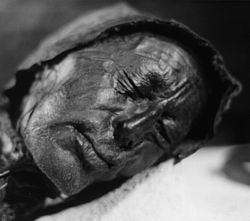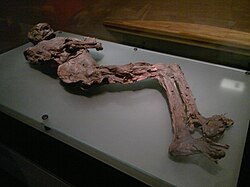

A bog body is a human cadaver that has been naturally mummified in a peat bog. Such bodies, sometimes known as bog people, are both geographically and chronologically widespread, having been dated to between 8000 BC and the Second World War.[1] The unifying factor of the bog bodies is that they have been found in peat and are partially preserved; however, the actual levels of preservation vary widely from perfectly preserved to mere skeletons.[2]
Unlike most ancient human remains, bog bodies often retain their skin and internal organs due to the unusual conditions of the surrounding area. Combined, highly acidic water, low temperature, and a lack of oxygen preserve but severely tan their skin. While the skin is well-preserved, the bones are generally not, due to the dissolution of the calcium phosphate of bone by the peat's acidity.[3] The acidic conditions of these bogs allow for the preservation of materials such as skin, hair, nails, wool and leather which all contain the protein keratin.[3]
The oldest known bog body is the skeleton of Koelbjerg Man from Denmark, which has been dated to 8000 BC, during the Mesolithic period.[1] The oldest fleshed bog body is that of Cashel Man, which dates to 2000 BC during the Bronze Age.[4] The overwhelming majority of bog bodies – including examples such as Tollund Man, Grauballe Man and Lindow Man – date to the Iron Age and have been found in northwest Europe, particularly Denmark, Germany, the Netherlands, United Kingdom, Sweden, Poland, and Ireland.[5][6] Such Iron Age bog bodies typically show a number of similarities, such as violent deaths and a lack of clothing, which has led archaeologists to believe that they were killed and deposited in the bogs as a part of a widespread cultural tradition of human sacrifice or executed as criminals.[1][7] Bogs could have indeed been seen as liminal places positively connected to another world, which might welcome contaminating items otherwise dangerous to the living.[7] More recent theories postulate that bog people were perceived as social outcasts or "witches", as legal hostages killed in anger over broken treaty arrangements, or as victims of an unusual death eventually buried in bogs according to traditional customs.[7]
The German scientist Alfred Dieck published a catalogue of more than 1,850 bog bodies that he had counted between 1939 and 1986,[8][9] but most were unverified by documents or archaeological finds;[10] and a 2002 analysis of Dieck's work by German archaeologists concluded that much of his work was unreliable.[10] Countering Dieck's findings of more than 1400 bog body discoveries, it seems that after a more recent study the number of bog body finds is closer to 122.[11] The most recent bog bodies are those of soldiers killed in the wetlands of the Soviet Union during the Second World War.[1]
- ^ a b c d Fischer 1998. p. 237.
- ^ Van der Sanden 1996. p. 7.
- ^ a b Munksgaard, Elisabeth (1 January 1984). "Bog Bodies: A Brief Survey of Interpretations". Journal of Danish Archaeology. 3 (1): 120–123. doi:10.1080/0108464X.1984.10589917. ISSN 0108-464X.
- ^ Cite error: The named reference
kingswas invoked but never defined (see the help page). - ^ Connolly, R. C. (1985). "Lindow Man: Britain's Prehistoric Bog Body". Anthropology Today. 1 (5): 15–17. doi:10.2307/3032823. ISSN 0268-540X. JSTOR 3032823.
- ^ Menotti, Francesco; O'Sullivan, Aidan (2012). The Oxford Handbook of Wetland Archaeology. OUP Oxford. ISBN 978-0-19-162618-0.
- ^ a b c Randsborg 2015, pp. 7–8.
- ^ Dieck, Alfred (1965). Die europäischen Moorleichenfunde (Hominidenmoorfunde) (in German). Neumünster: Wachholtz. pp. 136pp.
- ^ Glob 1969, pp. 101.
- ^ a b Eisenbeiß, Sabine (2003). Bauerochse, Andreas (ed.). Bog-bodies in Lower Saxony – rumours and facts: an analysis of Alfred Dieck's sources of information. Peatlands: archaeological sites, archives of nature, nature conservation, wise use; proceedings of the Peatland Conference 2002 in Hannover, Germany. Rhaden/Westf.: Leidorf. pp. 143–150. ISBN 3-89646-026-9.
- ^ Cockburn, Aidan; Cockburn, Eve; Reyman, Theodore A. (1998). Mummies, Disease and Ancient Cultures. Cambridge University Press. ISBN 978-0-521-58954-3.